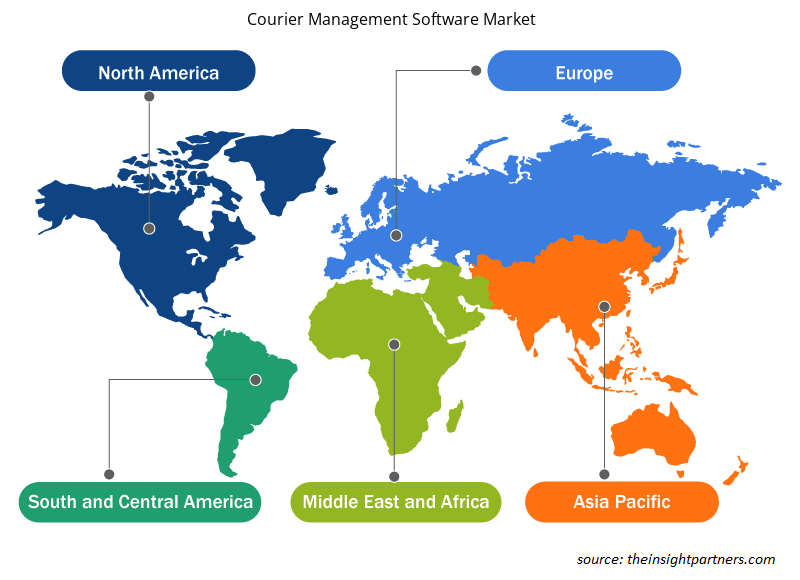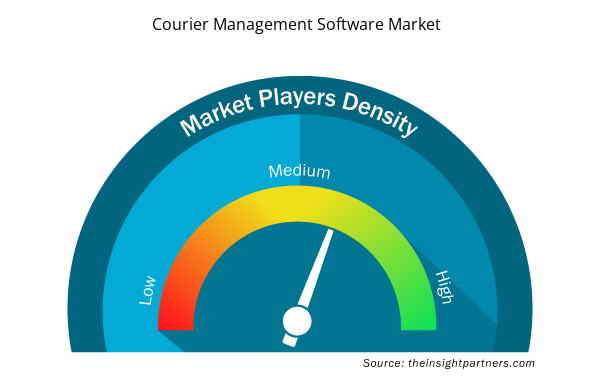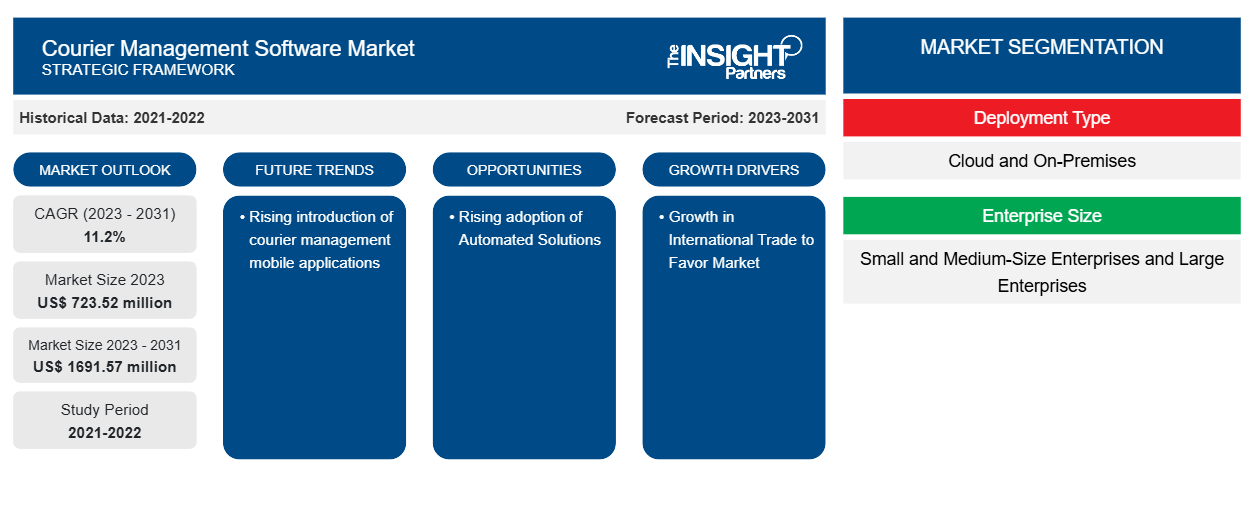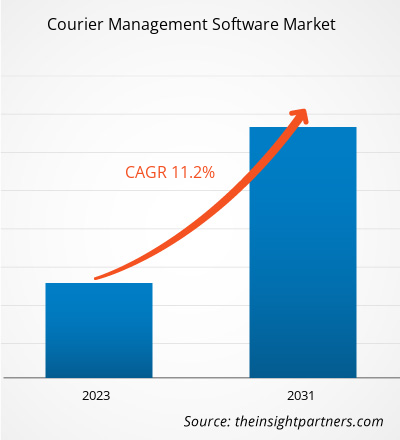Der globale Markt für Kuriermanagement-Software wird voraussichtlich von 723,52 Millionen US-Dollar im Jahr 2023 auf 1691,57 Millionen US-Dollar im Jahr 2031 wachsen; von 2023 bis 2031 wird eine durchschnittliche jährliche Wachstumsrate von 11,2 % erwartet. Die zunehmende Einführung mobiler Anwendungen für das Kuriermanagement wird voraussichtlich ein wichtiger Trend auf dem Markt für Kuriermanagement-Software bleiben.
Marktanalyse für Kuriermanagementsoftware
Das Wachstum des internationalen Handels wird sich voraussichtlich positiv auf den Markt für Kuriermanagementsoftware auswirken. Mit zunehmendem internationalen Handel steigt auch die Nachfrage nach effizienten Logistik- und Liefermanagementlösungen.
Marktübersicht für Kuriermanagementsoftware
Kuriermanagementsoftware ist eine umfassende Softwarelösung, die Unternehmen dabei unterstützt, Versandaufträge für Pakete oder Produkte effizient zu verwalten und zu verfolgen. Diese Software bietet eine Reihe von Funktionen und Funktionalitäten, die verschiedene Aspekte des Lieferprozesses rationalisieren und so letztendlich die Kundenzufriedenheit verbessern und die Betriebseffizienz optimieren. Kuriersoftware bietet GPS-Überwachung von Sendungen in Echtzeit, sodass Unternehmen den Status und den Standort von Paketen während des gesamten Lieferprozesses verfolgen können.
Passen Sie diesen Bericht Ihren Anforderungen an
Sie erhalten kostenlos individuelle Anpassungen an jedem Bericht, einschließlich Teilen dieses Berichts oder einer Analyse auf Länderebene, eines Excel-Datenpakets sowie tolle Angebote und Rabatte für Start-ups und Universitäten.
- Holen Sie sich die wichtigsten Markttrends aus diesem Bericht.Dieses KOSTENLOSE Beispiel umfasst eine Datenanalyse von Markttrends bis hin zu Schätzungen und Prognosen.
Markttreiber und Chancen für Kuriermanagementsoftware
Wachstum im internationalen Handel begünstigt den Markt
Das Wachstum des internationalen Handels wirkt sich positiv auf den Markt für Kuriermanagementsoftware aus. Mit zunehmendem internationalen Handel steigt auch die Nachfrage nach effizienten Logistik- und Liefermanagementlösungen. Internationaler Handel umfasst den Austausch von Waren und Dienstleistungen zwischen Ländern. Er erfordert eine effektive Koordination und Verwaltung der Logistik, einschließlich Transport, Lagerung und Lieferung. Kuriermanagementsoftware spielt eine entscheidende Rolle bei der Rationalisierung dieser Prozesse, der Verbesserung der Effizienz und der Gewährleistung einer pünktlichen Warenlieferung.
Zunehmende Nutzung automatisierter Lösungen
Die wachsenden Investitionen in Kuriersoftware durch E-Commerce-Unternehmen und die steigende Popularität von Software as a Service (SaaS) treiben den Kuriersoftwaremarkt voran. Diese Softwaresysteme spielen eine entscheidende Rolle bei der Rationalisierung von Geschäftsabläufen, der Verbesserung der Kundenkommunikation, der Echtzeittransparenz von Sendungen, der Optimierung von Routing-Optionen und vielem mehr. Durch die Integration von Kuriersoftware in ihre bestehenden Systeme können Unternehmen verschiedene Prozesse wie die Kundenauftragserfassung, Debitorenbuchhaltung, Echtzeit-Lieferverfolgung und Kontoverwaltung automatisieren. Um wettbewerbsfähig zu bleiben, implementieren Kuriersoftwareanbieter außerdem technologisch fortschrittliche und kundenorientierte Preisstrategien.
Marktbericht zur Kuriermanagementsoftware – Segmentierungsanalyse
Wichtige Segmente, die zur Ableitung der Marktanalyse für Kuriermanagementsoftware beigetragen haben, sind Bereitstellungstyp und Unternehmensgröße.
- Basierend auf dem Bereitstellungstyp ist der Markt in Cloud und On-Premises unterteilt. Das Cloud-Segment hatte im Jahr 2023 einen größeren Marktanteil.
- Basierend auf der Unternehmensgröße ist der Markt in kleine und mittlere Unternehmen sowie in Großunternehmen unterteilt. Das Segment der Großunternehmen hatte im Jahr 2023 einen größeren Marktanteil.
Marktanteilsanalyse für Kuriermanagementsoftware nach geografischer Lage
Der geografische Umfang des Marktberichts für Kuriermanagementsoftware ist hauptsächlich in fünf Regionen unterteilt: Nordamerika, Asien-Pazifik, Europa, Naher Osten und Afrika sowie Südamerika/Süd- und Mittelamerika. Nordamerika dominierte den Markt für Kuriermanagementsoftware im Jahr 2023. Aufgrund der wachsenden Beliebtheit von Kuriersoftware zur Verbesserung des Lieferkettenmanagements besteht eine steigende Nachfrage nach einer zuverlässigen Plattform, die End-to-End-Versandanforderungen für den Online-Einkauf sowohl wichtiger als auch nicht unbedingt notwendiger Produkte erfüllen kann. Der kommerzielle Sektor in der Region erlebt bedeutende technologische Fortschritte, die das Wachstum des Marktes für Kuriersoftware vorantreiben. Darüber hinaus trägt auch die rasche Einführung von Technologie im Industriesektor in nordamerikanischen Ländern zur Expansion des Marktes für Kuriersoftware in der Region bei.
Regionale Einblicke in den Markt für Kuriermanagementsoftware
Die regionalen Trends und Faktoren, die den Markt für Kuriermanagement-Software während des Prognosezeitraums beeinflussen, wurden von den Analysten von Insight Partners ausführlich erläutert. In diesem Abschnitt werden auch die Marktsegmente und die Geografie von Kuriermanagement-Software in Nordamerika, Europa, im asiatisch-pazifischen Raum, im Nahen Osten und Afrika sowie in Süd- und Mittelamerika erörtert.

- Erhalten Sie regionale Daten zum Markt für Kuriermanagement-Software
Umfang des Marktberichts zur Kuriermanagementsoftware
| Berichtsattribut | Details |
|---|---|
| Marktgröße im Jahr 2023 | 723,52 Millionen US-Dollar |
| Marktgröße bis 2031 | 1691,57 Millionen US-Dollar |
| Globale CAGR (2023 - 2031) | 11,2 % |
| Historische Daten | 2021-2022 |
| Prognosezeitraum | 2023–2031 |
| Abgedeckte Segmente | Nach Bereitstellungstyp
|
| Abgedeckte Regionen und Länder | Nordamerika
|
| Marktführer und wichtige Unternehmensprofile |
|
Marktteilnehmerdichte: Der Einfluss auf die Geschäftsdynamik
Der Markt für Kuriermanagement-Software wächst rasant, angetrieben durch die steigende Nachfrage der Endnutzer aufgrund von Faktoren wie sich entwickelnden Verbraucherpräferenzen, technologischen Fortschritten und einem größeren Bewusstsein für die Vorteile des Produkts. Mit steigender Nachfrage erweitern Unternehmen ihr Angebot, entwickeln Innovationen, um die Bedürfnisse der Verbraucher zu erfüllen, und nutzen neue Trends, was das Marktwachstum weiter ankurbelt.
Die Marktteilnehmerdichte bezieht sich auf die Verteilung der Firmen oder Unternehmen, die in einem bestimmten Markt oder einer bestimmten Branche tätig sind. Sie gibt an, wie viele Wettbewerber (Marktteilnehmer) in einem bestimmten Marktraum im Verhältnis zu seiner Größe oder seinem gesamten Marktwert präsent sind.
Die wichtigsten auf dem Markt für Kuriermanagement-Software tätigen Unternehmen sind:
- Courier Software Ltd
- KurierManager
- Delhivery
- Datatrac Corporation
- Digitaler Frachtbrief
- Wichtige Softwaresysteme
Haftungsausschluss : Die oben aufgeführten Unternehmen sind nicht in einer bestimmten Reihenfolge aufgeführt.

- Überblick über die wichtigsten Akteure auf dem Markt für Kuriermanagementsoftware
Nachrichten und aktuelle Entwicklungen zum Markt für Kuriermanagementsoftware
Der Markt für Kuriermanagementsoftware wird durch die Erhebung qualitativer und quantitativer Daten nach Primär- und Sekundärforschung bewertet, die wichtige Unternehmensveröffentlichungen, Verbandsdaten und Datenbanken umfasst. Im Folgenden finden Sie eine Liste der Entwicklungen auf dem Markt:
- Im September 2023 hat Delhivery, ein Logistikdienstleister, kürzlich eine Location-Intelligence-Lösung namens „LocateOne“ auf den Markt gebracht, die Unternehmen dabei helfen soll, Adressdaten und Genauigkeit zu verbessern und Betrug zu reduzieren. Diese neue Funktion ist Teil des Softwareangebots von Delhivery auf der OS1-Plattform. OS1 ist eine Softwareplattform, die Unternehmen umfassende Lösungen bietet, um ihre Logistik- und Lieferkettenabläufe effizient zu betreiben.
(Quelle: Delhivery, Pressemitteilung, 2023)
Marktbericht zur Kuriermanagementsoftware – Umfang und Ergebnisse
Der Bericht „Marktgröße und Prognose für Kuriermanagement-Software (2021–2031)“ bietet eine detaillierte Analyse des Marktes, die die folgenden Bereiche abdeckt:
- Marktgröße und Prognose auf globaler, regionaler und Länderebene für alle wichtigen Marktsegmente, die im Rahmen des Projekts abgedeckt sind
- Marktdynamik wie Treiber, Beschränkungen und wichtige Chancen
- Wichtige Zukunftstrends
- Detaillierte PEST/Porters Five Forces- und SWOT-Analyse
- Globale und regionale Marktanalyse mit wichtigen Markttrends, wichtigen Akteuren, Vorschriften und aktuellen Marktentwicklungen
- Branchenlandschaft und Wettbewerbsanalyse, einschließlich Marktkonzentration, Heatmap-Analyse, prominenten Akteuren und aktuellen Entwicklungen
- Detaillierte Firmenprofile
- Historische Analyse (2 Jahre), Basisjahr, Prognose (7 Jahre) mit CAGR
- PEST- und SWOT-Analyse
- Marktgröße Wert/Volumen – Global, Regional, Land
- Branche und Wettbewerbsumfeld
- Excel-Datensatz



Report Coverage
Revenue forecast, Company Analysis, Industry landscape, Growth factors, and Trends

Segment Covered
This text is related
to segments covered.

Regional Scope
North America, Europe, Asia Pacific, Middle East & Africa, South & Central America

Country Scope
This text is related
to country scope.
Häufig gestellte Fragen
The courier management software market size is expected to grow from US$ 723.52 million in 2023 to US$ 1691.57 million by 2031; it is anticipated to expand at a CAGR of 11.2% from 2024 to 2031.
The growth in international trade is expected to have a positive impact on the courier management software market.
The rising introduction of courier management mobile applications is likely to remain a key courier management software market trends.
The key players holding the majority of shares in the global courier management software market are Courier Software Ltd, CourierManager, Delhivery, Datatrac Corporation, and Digital Waybill.
The global courier management software market is expected to reach US$ 1691.57 million by 2031.
Trends and growth analysis reports related to Technology, Media and Telecommunications : READ MORE..
The Insight Partners performs research in 4 major stages: Data Collection & Secondary Research, Primary Research, Data Analysis and Data Triangulation & Final Review.
- Data Collection and Secondary Research:
As a market research and consulting firm operating from a decade, we have published and advised several client across the globe. First step for any study will start with an assessment of currently available data and insights from existing reports. Further, historical and current market information is collected from Investor Presentations, Annual Reports, SEC Filings, etc., and other information related to company’s performance and market positioning are gathered from Paid Databases (Factiva, Hoovers, and Reuters) and various other publications available in public domain.
Several associations trade associates, technical forums, institutes, societies and organization are accessed to gain technical as well as market related insights through their publications such as research papers, blogs and press releases related to the studies are referred to get cues about the market. Further, white papers, journals, magazines, and other news articles published in last 3 years are scrutinized and analyzed to understand the current market trends.
- Primary Research:
The primarily interview analysis comprise of data obtained from industry participants interview and answers to survey questions gathered by in-house primary team.
For primary research, interviews are conducted with industry experts/CEOs/Marketing Managers/VPs/Subject Matter Experts from both demand and supply side to get a 360-degree view of the market. The primary team conducts several interviews based on the complexity of the markets to understand the various market trends and dynamics which makes research more credible and precise.
A typical research interview fulfils the following functions:
- Provides first-hand information on the market size, market trends, growth trends, competitive landscape, and outlook
- Validates and strengthens in-house secondary research findings
- Develops the analysis team’s expertise and market understanding
Primary research involves email interactions and telephone interviews for each market, category, segment, and sub-segment across geographies. The participants who typically take part in such a process include, but are not limited to:
- Industry participants: VPs, business development managers, market intelligence managers and national sales managers
- Outside experts: Valuation experts, research analysts and key opinion leaders specializing in the electronics and semiconductor industry.
Below is the breakup of our primary respondents by company, designation, and region:

Once we receive the confirmation from primary research sources or primary respondents, we finalize the base year market estimation and forecast the data as per the macroeconomic and microeconomic factors assessed during data collection.
- Data Analysis:
Once data is validated through both secondary as well as primary respondents, we finalize the market estimations by hypothesis formulation and factor analysis at regional and country level.
- Macro-Economic Factor Analysis:
We analyse macroeconomic indicators such the gross domestic product (GDP), increase in the demand for goods and services across industries, technological advancement, regional economic growth, governmental policies, the influence of COVID-19, PEST analysis, and other aspects. This analysis aids in setting benchmarks for various nations/regions and approximating market splits. Additionally, the general trend of the aforementioned components aid in determining the market's development possibilities.
- Country Level Data:
Various factors that are especially aligned to the country are taken into account to determine the market size for a certain area and country, including the presence of vendors, such as headquarters and offices, the country's GDP, demand patterns, and industry growth. To comprehend the market dynamics for the nation, a number of growth variables, inhibitors, application areas, and current market trends are researched. The aforementioned elements aid in determining the country's overall market's growth potential.
- Company Profile:
The “Table of Contents” is formulated by listing and analyzing more than 25 - 30 companies operating in the market ecosystem across geographies. However, we profile only 10 companies as a standard practice in our syndicate reports. These 10 companies comprise leading, emerging, and regional players. Nonetheless, our analysis is not restricted to the 10 listed companies, we also analyze other companies present in the market to develop a holistic view and understand the prevailing trends. The “Company Profiles” section in the report covers key facts, business description, products & services, financial information, SWOT analysis, and key developments. The financial information presented is extracted from the annual reports and official documents of the publicly listed companies. Upon collecting the information for the sections of respective companies, we verify them via various primary sources and then compile the data in respective company profiles. The company level information helps us in deriving the base number as well as in forecasting the market size.
- Developing Base Number:
Aggregation of sales statistics (2020-2022) and macro-economic factor, and other secondary and primary research insights are utilized to arrive at base number and related market shares for 2022. The data gaps are identified in this step and relevant market data is analyzed, collected from paid primary interviews or databases. On finalizing the base year market size, forecasts are developed on the basis of macro-economic, industry and market growth factors and company level analysis.
- Data Triangulation and Final Review:
The market findings and base year market size calculations are validated from supply as well as demand side. Demand side validations are based on macro-economic factor analysis and benchmarks for respective regions and countries. In case of supply side validations, revenues of major companies are estimated (in case not available) based on industry benchmark, approximate number of employees, product portfolio, and primary interviews revenues are gathered. Further revenue from target product/service segment is assessed to avoid overshooting of market statistics. In case of heavy deviations between supply and demand side values, all thes steps are repeated to achieve synchronization.
We follow an iterative model, wherein we share our research findings with Subject Matter Experts (SME’s) and Key Opinion Leaders (KOLs) until consensus view of the market is not formulated – this model negates any drastic deviation in the opinions of experts. Only validated and universally acceptable research findings are quoted in our reports.
We have important check points that we use to validate our research findings – which we call – data triangulation, where we validate the information, we generate from secondary sources with primary interviews and then we re-validate with our internal data bases and Subject matter experts. This comprehensive model enables us to deliver high quality, reliable data in shortest possible time.


 Holen Sie sich ein kostenloses Muster für diesen Bericht
Holen Sie sich ein kostenloses Muster für diesen Bericht